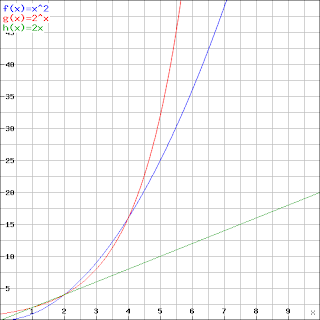As I mentioned in Part I of this post (here), technology is changing at an accelerating pace – an exponential pace – according to Raymond Kurzweil. Here is a graph of three curves: a linear function in green (y=2x), a polynomial function in blue (y=x^2), and an exponential function in red (y=2^x).
 |
| Imagine the X axis as time (days or years, for example) |
If you see the bottom as time, you can see how powerful exponential growth is. Look how quickly the exponential growth (in red) skyrockets. That red line represents simply doubling something every one unit (let’s assume time and make it years along the bottom). That’s how my laptop winds up outpowering NASA’s computers of the 1960’s in just 42 years. We should never forget, however, that while the acceleration of technology that people Ray Kurzweil and Gordon Moore have noted can be graphed in this mathematically precise way, technology doesn’t change in such a linear and precise fashion. Technological changes don’t follow such a “flat” 2-dimensional graph.
I previously noted Toffler’s assertion in “Future Shock” about people going insane at the breakdowns in social mores and cohesion brought on by rapid technological advances. George Orwell foresaw a dystopian world in which “Big Brother” looked at at all of us from our TV sets in his book 1984. And yet look at how two inventions like the smartphone and Facebook proved them both wrong (and right, simultaneously). Whenever I’m at a meeting and there’s a break, I’ll take a moment to look around the room when the speaker (or me, if I’m lecturing) announces there’s a 10 minute break. Immediately, everyone is on their Blackberry, Droid, or iPhone, connecting with other people half a world away, utterly disconnected from those of us in the same room (perhaps proving Toffler correct) – yet, they are instantly connected to loved ones, friends, a social circle, from which they would be otherwise isolated. And they provide information (have you used the “checking in” function on Facebook?) about themselves – location, time, personal thoughts, feelings, pictures, etc. – that would have made Orwell blanch; and it didn’t take a government or “Big Brother” to do it. All it took was Mike Zuckerberg.
Which leads me to caveat both Kurzweil and Moore’s “laws” by noting that the graph would do better to be in 3 dimensions, to show how the changes can move in ways that are linear, yet not always predictable. My graph of “Kurzweil’s Corollary” would look like this:
In my re-imagining of Kurzweil’s point, a third dimension gets added to reflect how technology, while still following an exponential growth, can hem-stitch back and forth along the z-axis in unexpected (if still rapid) ways.
The point of all of this is to lead us to some of the conclusions Kurzweil reached about this growth of technology, specifically with computers. Kurzweil’s specialty, as Lev Grossman points out in the Time article I’m commenting on, is artificial intelligence. At a summit at NASA in 1993, a science-fiction writer Vernor Vinge opined that “in 30 years [that would 12 years from now] we will have the technological means to create super-human intelligence. Shortly after, the human era will be ended.”
Kurzweil has extended out the curves I provided above in a number of different areas and his opined that by the mid-2020’s we will successfully reverse engineer the human brain and that “[b]y the end of that decade, computers will be capable of human-level intelligence. Kurzweil puts the date of the Singularity… at 2045.” (Read more at: http://www.time.com/time/health/article/0,8599,2048138,00.html#ixzz1P5xLhkKS).

